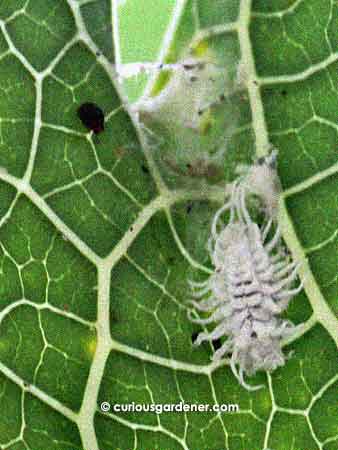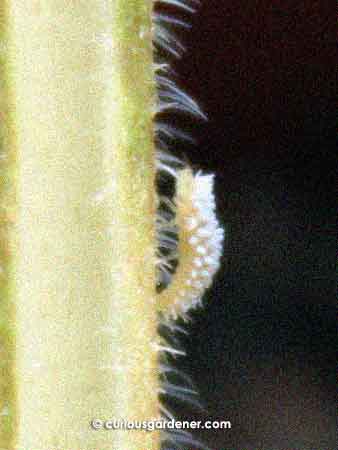I caught myself in a bit of a dilemma recently. You know how I have an immediate reaction to seeing white insects on my plants – they’ve usually proven to be pests like mealybugs and white flies – which are actually a little rampant at the moment. So, when I saw a few white insects scuttling around on my only comfrey plant, I went into immediate protective mode.
Something made me peer at the little white things before I started squishing them, thought, and I realized that they looked awfully like albino ladybug nymphs.
The familiar spiny protuberances, humped kind of back and fast scuttling clued me in, and that saved them from an early death.
Naturally, finding something new and good thrilled me, and of course I wanted to find out more about these white babies. I couldn’t observe them so well because the thing about ladybug larvae appearing on potted versus plants growing out in the garden is that they tend to disappear when they reach pupa stage. I suspect they find nice nooks like under the rims of the flower pots that are either too low down and heavy for us huge humans to examine easily.
In other words, I lost track of them… ![]()
So, I had to get online to try to find out more about these white larvae. I expected to find out that they developed into white or light coloured ladybugs, but that was not the case. While there are indeed white ladybugs, these white larvae of the Scymnus sp. or dusky ladybug develop into dark ladybugs – and I have seen such little beetles in the garden.
I also learned something else about white ladybug larvae – besides being covered in those alligator-like bumps, they could also have thinner, longer protuberances – kind of like this:

I find it so hard to believe that this fierce-looking, scorpion-like white insect is supposed to be a ladybug larvae, but that's what I've seen online. Above in the left is what I suspect to be a scymnus ladybug. They are on the underside of a papaya leaf.
Looks like a mealybug, doesn’t it?
I thought so too.

The undersides of my brinjal plant's leaves attract yellow aphids, and here we see the white ladybug larvae hungrily approaching an unwary aphid.
I’ve seen these insects on several plants that had mealybug and aphid infestations, and assumed that they were mealies in one of their growth stages. Well, from what I’ve read online, they’re the larva of the scymnus genus of ladybugs – and if you look at the picture of the larvae above, you ‘ll notice a small beetle also in the shot. I may be wrong, but I think that’s one of the dusky ladybugs – really small and difficult to get in focus especially when you’re taking a photo from under a leaf with the light above it.
Well, like I’ve said, I’ve seen these white things together with other pests, and it now saddens me to admit that I’ve blitzed these larva together with the other pests with white oil spray. It didn’t strike me that they weren’t all pests that were destroying my plants. ![]()
The moral of all this? Know your pests and beneficial insects in all their life stages. I know that I will still have to condition myself not to jump to conclusions when I see clusters of insects on plants that are starting to show signs of losing good health. There is no such thing as a plant attracting only pests or beneficial insects; something always attracts something else in nature, and they all strive for dominance or balance. We just have to pay better attention and understand better.


Oh, I’ve seen what I think may be a ladybug nymph once! Like the pictures you took. We were all wondering what type of monstrous mealy it was when we realized it was moving too fast to be a mealy.
https://fbcdn-sphotos-a.akamaihd.net/hphotos-ak-ash2/26092_381400106287_517126287_4369477_4923052_n.jpg
My “guide” to telling if it’s a ladybug gonnabe is looking at the head. The nymphs seem to have a small rounded head just ahead of the thorax, with the big round black eyes, like a cartoon character. Of course it’s still guesswork for now, but still cool to see the many forms they can take. The nymph in your pic is really intriguing!
I don’t get beneficial insects over here (only beneficial animals like geckos and spiders) so I can’t comment much. Lol.
But you’re right: the one I photographed looks very interesting…like some well-armored soldier going to war.
Your insect looks like a stag with really impressive antlers!
And it’s a trade-off – I have beneficial insects but I’ve also got more pests!